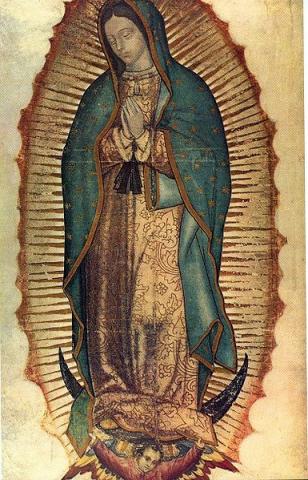
Tepeyac, Mexico
.
Tepeyac, Mexico is the site of the miraculous apparition of Our Lady of Guadalupe (a.k.a., "La Virgen de Guadalupe" in Spanish) to the Native Aztec Indian, Juan Diego, in a series of four apparitions from December 9-12, 1531. Tepeyac is in Mexico City at a place native Mexicans refer to as "La Villa" (The Village)*.
La Virgen caused her own image to appear on the tilma of Juan Diego and asked that a cathedral be built in her honor. When this image was shown to Archbishop Zumarraga of Mexico City, and then to the people of Mexico, it verified the miracle to 11 million Mexican Indians who converted as a result and helped to stamp out pagan Aztec beliefs once and for all (but which, unfortunately, are making somewhat of a comeback in the new paganized world and church). The tilma of Juan Diego with Our Lady's miraculous image printed upon it is now displayed high above the altar of the rather unsightly, modern-style "Basilica" of Our Lady of Guadalupe, (built by modernist Mexican architect, Pedro Ramirez Vasquez, with "indigenous" elements) although it formerly rested above the altar of a beautiful old Spanish colonial cathedral (which we hope it may someday return to, or something like it). Despite the unsightly exterior (and interior!) of the "new" "basilica," the beautiful image of La Virgen within has caused it to become the most visited pilgrimage site in the once-Catholic world.
Our Lady of Guadalupe is of particular interest to us here at teclahashimoto.com because she appeared before an image of the sun, representing the Sun-God of the Aztecs whom she came to replace and destroy--and the sun is a great ball of fire. As we know, Tecla too appears in a great ball of flame. Furthermore, La Virgen appeared with a black silk ribbon around her waist which to the Aztecs represented a woman with child--earning her the moniker "Patroness of the Unborn"--and, as we know, Tecla too, while "clothed with the sun" carried a child in her womb. Both women are therefore reflective of the passage from Apocalypse 12:1-3 which describes "A woman clothed with the sun....crying out in childbirth," although this passage refers more directly to the Virgin of Guadalupe, of whom Tecla is the most magnificent type. Needless to say, this passage of Scripture is prophetic of the End Times and the final battle between Good and Evil, Heaven and Hell, the True Catholic Church and all the ungodly powers arrayed against it.
A former acquaintance of mine from Puebla, Mexico, tells me that the story of La Virgen was prophesied in the name of Christpher Columbus' two caravels--The Nina and The Pinta--and the larger nao--The Santa Maria--when he crossed the Atlantic to discover America on October 12, 1492. That is because "La Nina Pinta La Santa Maria" literally translates to "The Little Lady Painted St. Mary," as did the Virgen de Guadalupe on the tilma of Juan Diego.** Even Richard Wagner (1813-1883), the great German opera composer, got into the act when he unconsciously created a fictional type of both Tecla Hashimoto and La Virgen de Guadalupe in the character of Brunnhilde, who, at the end of the epic Der Ring des Nibelungen leaps into the fire for the Downfall of the Gods and the Redemption of the World Through Love while singing a motif of pregnancy (see "Bayreuth, Germany" from the "Places" page).
* short for "La Villa de Guadalupe Hidalgo," one of the 16 districts of Mexico city.
**Juan Diego referred to the woman of the apparition as "My little lady," as was the Aztec custom of the time.
